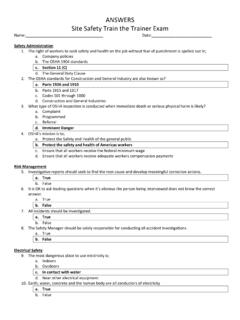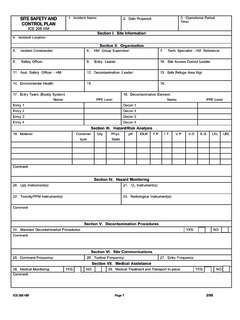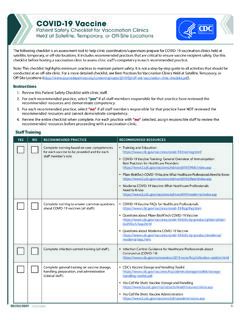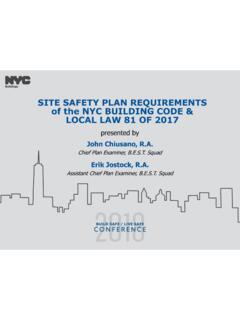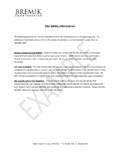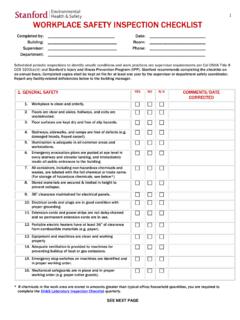Transcription of Decibel (Loudness) Comparison Chart
1 Website and additional information available to all students, Faculty, and staff. HEARING It is important that proper precautions are made in protecting yourself from hearing loss. Decibel levels exceeding 90 or more should be limited to no more than 2 to 3 hours per day. Therefore it is essential to not have 3 or more large ensemble rehearsals back to back. Students are encouraged to supplement information obtained in their lessons, master classes, and guest lectures regarding musicians' health and safety issues by utilizing some of the resources listed below. Decibel (Loudness) Comparison Chart Here are some interesting numbers, collected from a variety of sources that help one to understand the volume levels of various sources and how they can affect our hearing. Environmental Noise Weakest sound heard 0dB Whisper Quiet Library at 6' 30dB Normal conversation at 3' 60-65dB Telephone dial tone 80dB City Traffic (inside car)
2 85dB Train whistle at 500', Truck Traffic 90dB Jackhammer at 50' 95dB Subway train at 200' 95dB Level at which sustained exposure may result in hearing loss 90 - 95dB Hand Drill 98dB Power mower at 3' 107dB Snowmobile, Motorcycle 100dB Power saw at 3' 110dB Sandblasting, Loud Rock Concert 115dB Pain begins 125dB Pneumatic riveter at 4' 125dB Even short term exposure can cause permanent damage - Loudest recommended exposure WITH hearing protection 140dB Jet engine at 100' 140dB 12 Gauge Shotgun Blast 165dB Death of hearing tissue 180dB Loudest sound possible 194dB OSHA Daily Permissible Noise Level Exposure Hours per day Sound level 8 90dB 6 92dB 4 95dB 3 97dB 2 100dB 102dB 1 105dB .5 110dB .25 or less 115dB NIOSH Daily Permissible Noise Level Exposure Hours per day Sound level 8 85dBA 6 86dBA 4 88dBA 3 89dBA 2 90dBA 92dBA 1 94dBA .5 97dBA.
3 25 or less 100dBA 0 112dBA Perceptions of Increases in Decibel Level Imperceptible Change 1dB Barely Perceptible Change 3dB Clearly Noticeable Change 5dB About Twice as Loud 10dB About Four Times as Loud 20dB Sound Levels of Music Normal piano practice 60 -70dB Fortissimo Singer, 3' 70dB Chamber music, small auditorium 75 - 85dB Piano Fortissimo 84 - 103dB Violin 82 - 92dB Cello 85 -111dB Oboe 95-112dB Flute 92 -103dB Piccolo 90 -106dB Clarinet 85 - 114dB French horn 90 - 106dB Trombone 85 - 114dB Tympani & bass drum 106dB Walkman on 5/10 94dB Symphonic music peak 120 - 137dB Amplifier, rock, 4-6' 120dB Rock music peak 150dB HEALTH AND INJURY Practicing properly is essential to every musician s best interest. Please refer to your applied teacher in utilizing proper techniques and exposure to prolonged strain on muscle groups, tendons, and bones associated with your instrument or voice.
4 PERFORMANCE ANXIETY TECHNOLOGY safety EQUIPMENT MOVING Students working as stage managers in Brock, Foster, or Campbell must complete a training session on how to safely move the grand pianos on stage. Contact Greg Sexton for information. Students working as audio/recording technicians must complete a training session on how to safely use the sound system and recording equipment, and how to safely lift and carry stage monitors. Contact Dennis Davis for information. Health and safety Standards 1. Information a. Health and safety standards are very important to the department of music at Eastern Kentucky University. Various methods and expectations are clearly outlined in several documents including links and downloadable materials from our website. All faculty, students, staff, and guests have access to these documents plus several guest artists and courses have been offered to help faculty, staff, and students become more aware of these standards.
5 University safety regulations were established for all units on campus and a dedicated safety Manual was produced for the department. This 25-page document contains aspects related to day-to-day operations to terrorist threats. This document contains information and map diagrams of entire music building and all performance venues. Also each department was provided a weather radio and emergency bag for major threats such as fire, tornados, and gas leaks from area Army Depot. Students within our unit are given at least five lectures on safety and health concerns including 1. Moving of heavy materials, 2. Practicing properly to avoid injuries, 3. Hearing loss and long exposure to decibels over 100, 4. Performance Anxiety and 5. Health and safety of the voice. 1. Demonstrations and training are provided for all parties on how to properly move a grand piano, set up risers, chairs, and moving of percussion instruments.
6 Without this training, individuals are not allowed to move these objects and must seek assistance from our piano technician, music lab supervisor, or other trained individuals. 2. Additional demonstrations are provided and open to all students regarding proper practice techniques to avoid injury. Guest lectures are scheduled throughout each academic year pertaining to health practice habits, vocal safety and care, performance anxiety, and methods used throughout the music world like Alexander Technique. 3. In addition, Decibel readings were completed for all classrooms, performance venues, and practice rooms. These results were made available and appropriate steps were made to help areas that did not meet certain standards. New ceiling tiles that are more acoustically sound were placed throughout the music facilities to help bleed through and limit excessive Decibel levels.
7 Hearing loss handouts are provided to all students that include exposure times and instruments that cause the most damage at long exposed intervals. 4. All music majors take ASO 100, Freshman Orientation dedicated to music majors. This 16- week course has dedicated time covering all of these aspects plus much more. We offer a special topics MUS 310/510 course at both the undergraduate and graduate levels pertaining to performance anxiety and its Comparison to sports medicine and high level competitive training found in both sports and music. 5. Care of Your Irreplaceable Instrument! A Guide to Vocal Health for All Students I. Basic Health and Environment 1. Maintain good general health. Common colds and viruses are transmitted much more effectively by hands than by inhaling germs in the air.
8 Wash often and minimize contact with the mouth and nasal areas. 2. Consult medical personnel as appropriate for colds, flu, allergies, fever, sore throat, etc. However, proper amounts of vitamin C and zinc have been shown to be helpful for general health. 3. If your physician approves, get a flu shot each year. 4. Maintain body hydration. Drink an appropriate amount of water each day. Take into consideration your body weight, exercise, and age. Check with your physician for an accurate quantity. Soda, alcoholic beverages, and coffee do not replace water! When practicing/rehearsing, make sure you have water to drink. Small chunks of apple also help the mouth to stay hydrated during rehearsals. Dehydration will cause lack of laryngeal lubrication and will harm your instrument. 5. Exercise regularly (jogging, aerobics, swimming, light weight-lifting, etc.)
9 6. Eat a balanced diet. Excessively spicy food and/or eating a heavy meal before a nap or before retiring at night can cause problems due to flow of gastric hydrochloric acid into the esophagus and laryngeal areas. 7. Be careful of what you breathe. Exposure to smoke (even second-hand smoke), smog, and car exhaust is dangerous for the folds and for the respiratory system. Other social drug use is obviously detrimental to vocal and general health. 8. Speak in normal volume levels no matter what your environment. Don t compete with a loud environment. This means not trying to talk over the sounds around you from such sources as buses, airplanes, loud restaurants, construction machinery, sirens, etc. Also, cover your ears when the noise is very loud. Singers must be able to hear as well as sing! 9. Emotional unrest and physical or mental fatigue have a direct effect on the voice.
10 You can damage your vocal folds in trying to sound normal under such conditions. 10. Both air-conditioning and heat dry our environment. Humidify your house, apartment, or dorm room (especially in the winter) to about 40-50% humidity. An environment that promotes healthy plants will probably by good for you. Too much humidity can promote the growth of molds and mildews. These can be bad especially for the allergy-prone singer. In the summer, homes may need a dehumidifier to get rid of excess humidity. 11. Keep a careful check on back and neck postures. Vocal health and high skill level rely on correct alignment of the spine. II. Use of the Voice 11. Proper warm-ups are essential. A minimum of 15 minutes before choral or solo singing is necessary. Your voice teacher will guide you in the proper warm-up/technique. 12. Try to avoid scheduling too many rehearsals back to back.
